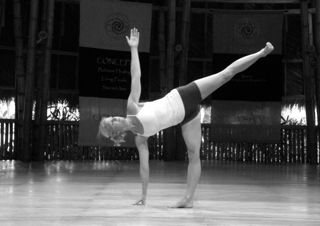25 Jan Q&A
At the moment I am assisting in the Kripalu Yoga Teacher Training at the Kripalu Center for Yoga & Health in Massachusetts. Inspired by practicing with one of the students last night, I am answering the following question:
Q: How do I come safely into the pose Ardha Chandrasana (Balancing Half Moon)?
A: Ardha Chandrasana is one of my favorite yoga poses. Not only because it is a challenging one – I like challenges – yet also because it is a pose in which you really need to open yourself, trust, and let go. This may feel like a contradiction at first – the tendency is to lean too far into the front of the body and to collapse the chest. Once you open your heart, pull your shoulder blades together and “lean” towards an imaginary wall behind you (feel a field of energy supporting you!), this pose is a true delight. At least for me it is. Try it, and see for yourself! Lucia, this one is for you:
ardha = half
chandra = glittering, shining, having the brilliancy or hue of light (said of the gods); usually translated as “moon”
Step by Step:
1. Practice Trikonosa (Triangle Pose) on your right side. As you exhale, lower your left hand to your left hip. Inhale, bend your right knee, and slide your left foot about 12 inches forward along the floor. At the same time, reach your right hand forward, in a diagonal from the little toe of the right foot, at least 12 inches. Keep a yoga block close. You may need to place it under your right hand.
2. Exhale, press your right heel firmly into the floor, and straighten your right leg, simultaneously lifting the left leg parallel (or a little above parallel) to the floor. Extend actively through the left heel to keep the raised leg strong. Be careful not to lock (and so hyperextend) the standing knee. Keep the kneecap aligned straight forward and don’t let it turn inward. Also, make sure you are not collapsing in the right hip, maintaining the alignment of ankle, knee and hip joint straight.
3. Rotate your upper torso to the left, but keep the left hip moving slightly forward at about a 30-degree angle. If you are a beginning yogi, keep your left hand on your left hip and your head in a neutral position, gazing forward. Otherwise, reach your left arm straight up to the ceiling, in line with your right arm, and bring your chin towards your left shoulder, gazing upwards.
4. Bear your body’s weight mostly on the standing leg. Press the lower hand (or finger tips) lightly to the floor (or block), using it to regulate your balance. Lift the arch of your standing foot strongly upward, as if drawing energy from the floor into the groin. Draw your shoulder blades together against the back torso, and lengthen your sacrum toward the raised heel. By pressing out of your standing foot, your right hand will come of the floor at some point. Focus on the center of your body (just below the navel) for a point of focus that will help your balance. “Lean” into your back body.
5. Stay in this position for 5 deep breaths. Then lower the raised leg to the floor with an exhalation, and return to Trikonasana. Practice the pose to the left for the same amount of breaths. It may feel good to practice Prasaritta Padotanasana (Standing Wide Angle) after this pose.
Enjoy!
